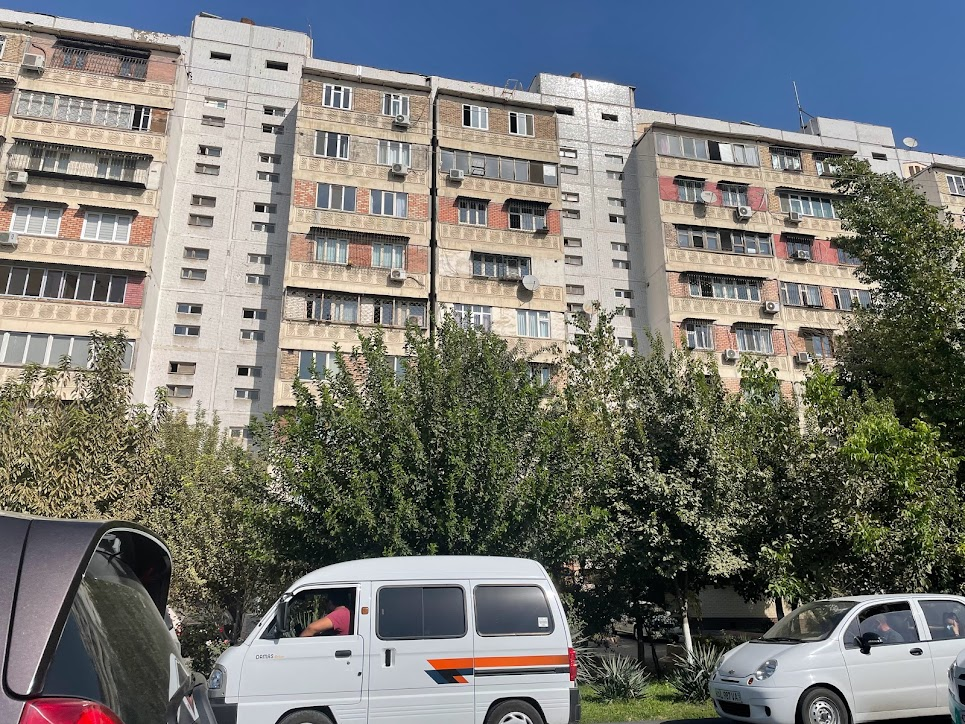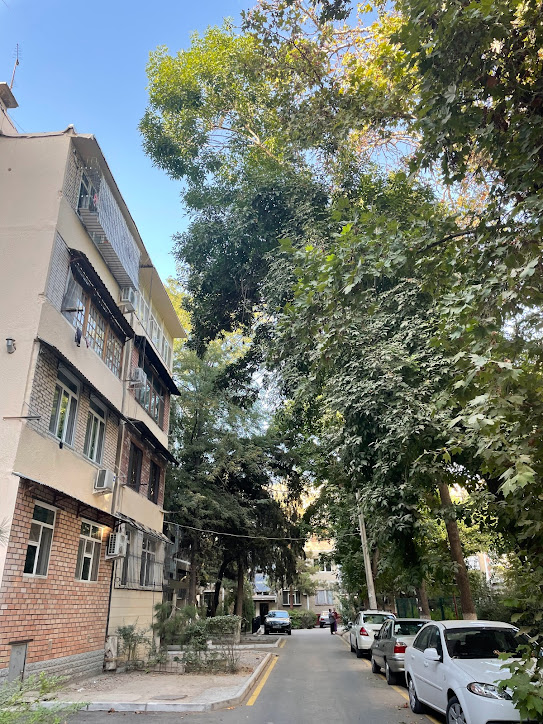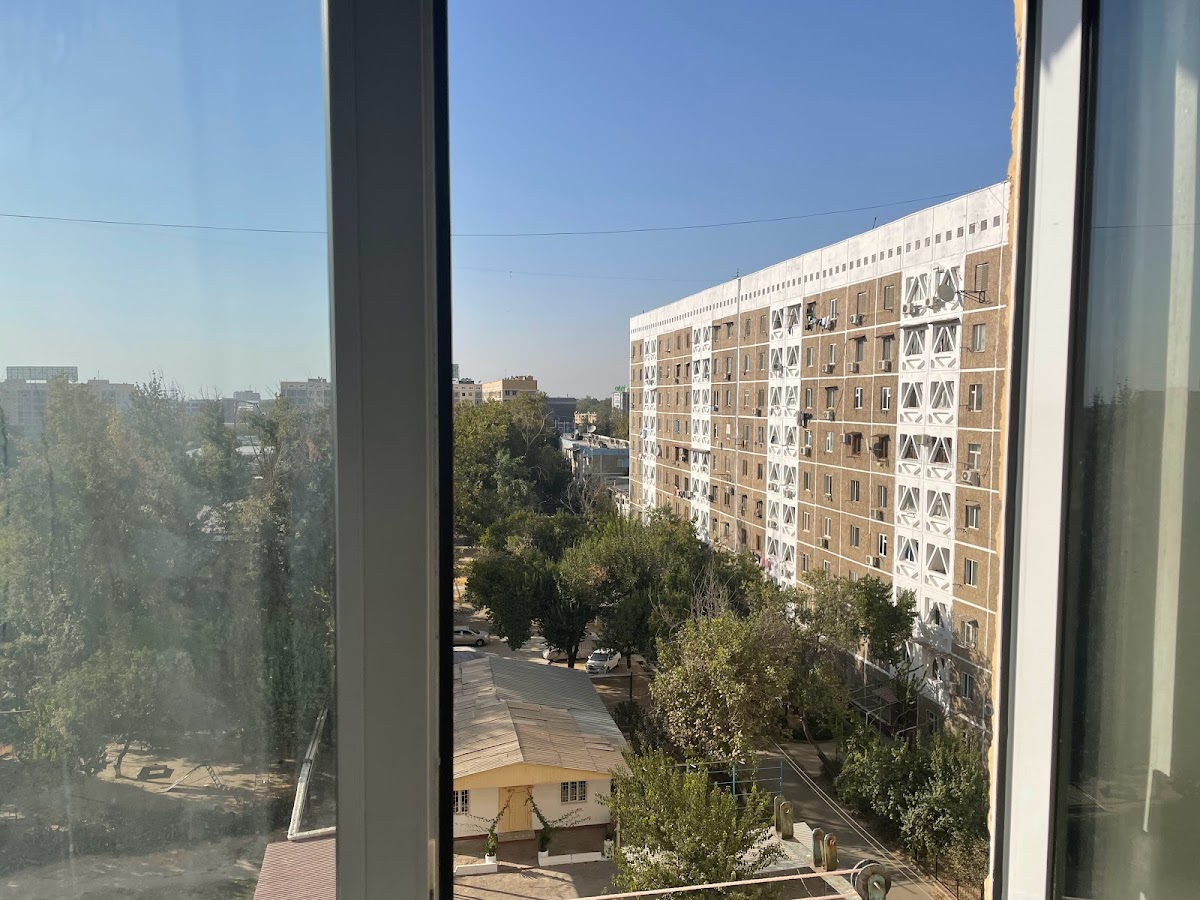Disclaimer: Within the article, the author changed common names in an effort to de-anglicize the word and further reclaim their mother tongue. For example, Uzbek became O’zbek, Tashkent, to Toshkent, Uyghur to Uyg’ur, Kkazakh to Qozoq, Kirghiz to Qirg’iz, Tajik to Tojik, and so on. Please refer to the end of the article for a glossary on common terms used throughout the article.
I close my eyes to remember: noises of traffic, warm desert breeze, blindingly bright and warm embrace of Central Asian sun, fruit trees, vibrant colors of the produce stands at the bazaar, bargaining voices, Turkic languages of all types in the air: Uyg’ur, O’zbek, Qozoq, Qirg’iz, Tojik blended with Russian. Embraces of family and neighbors, traditional one-story courtyard homes juxtaposed to the many multistory soviet apartments. A dynamically colorful and resilient city: this is Toshkent.
I see a nine-story soviet apartment, also known as do’m which translates to “house” in Russian. This do’m is located in the center of Toshkent in the Yunus Obod neighborhood, and it is my maternal grandparents’ home. It was a place of refuge in my childhood that helped me escape the chaos of my parents’ relationship. In my memories, this place has fragments of happiness and warmth: being surrounded by my three aunts and many cousins who would also visit, a place of play, full plates of food, Eid and New Year’s celebrations. Memories I re-remember so I won’t ever forget; they are a remedy to the bitterness of homesickness that has lived in my body since the age of nine, ever since we left Toshkent.

Many might imagine soviet apartments as the gray, monocolored Brutalist architectural homes predominantly existing in Eastern Europe. However, in order to understand the symbolic and material meaning of the soviet apartments, we must zoom out and center the long-forgotten history of Central Asia’s survival and resistance to Russia’s 127-year-long colonial project.
The colonial conquest of Turkeston, present-day Central Asia, took effect in 1865 by the Russian Empire, after decades of failed efforts by several competing European colonizers. The justification for colonization followed that of a similar narrative claimed by the other colonial powers—an effort to “civilize” and “modernize” the “less than human” Indigenous Central Asia. Toshkent quickly became the heart of this colonial project in the name of creating a “modern” city: serving as a military, political and economic center of Russian colonialism. The following settler-colonial agenda became the site of extraction, domination, militarization, surveillance, and the stripping of Indigenous culture. The soviet apartment is one example of many.
Soviet apartments contain a legacy of the USSR’s Imperial rule and its settler-colonial urban transformation, yet in complicated ways often appear in my memories, as a remembrance of safety and home. Having been displaced at such a young age due to poverty and chronic economic hardships in Toshkent, O’zbekiston, my immediate family and I were ripped away from our home through a pressurized immigration to the US as a means of survival. Since then, we have borne the weight of complete loss of community, place, and family, in addition to experiencing years of housing insecurity, poverty, and, for the first time in our lives, we became racialized, categorized, and othered. Thus to me, my memories of my city and my grandparents’ do’m is a rememory of safety and acceptance, no matter the do’m’s complicated colonial impacts.
The do’m I reference was my mother’s home. Her immediate family moved in the late 1980s from a traditional O’zbek mahalla or neighborhood in the southern part of the city, Ko’kcha and Eski Shahar district. She came from a mahalla made up of courtyard-style homes, called hovli, which uphold traditional Central Asian lifestyles. In my conversation with my mother, Madinahon, she explained her time transitioning from the hovli into the cement-built, colorless multistory soviet apartment, with similar notions of loss I mentioned above when referencing our migration to the US.
“In the 6th grade we moved…there was discomfort,” she said. “My cousins, they were the missing piece…I disliked [my new school] because it was not the same neighborhood-like school I came from. I cried [to my parents] that I did not want to go here, and wanted to go back to our old school. I really didn’t like my new school, I was very sad and I didn’t like the apartment either.”
In comparison, when she described her life before she moved that year, full of joy, her eyes lit up while telling me her favorite childhood memories:
“In my 50 years of living, the most amazing era for me was this one. We played and neighbors would join too. We played with so much fun. Life was excellent.”
The neighborhood she described with such fondness, was composed of Indigenous landscapes of narrow streets, crooked alleyways, beautifully sculptured “mazes” that historically left European settlers disoriented and lost. These homes fuse the bonds and reliance and reciprocity of neighbors and relatives, and are a place where multigenerational kinship is foundational.
“My life’s most amazing time was that time, in my youth. Five brothers [my paternal uncles and their families] side by side living together in these hovlis. Once you left outside, there was a school garden, and connected to it was a pre-school. These things were so close to us, we used to play at the schools. We collected semerenko apples and dipped them with salt and ate them. Amongst my cousins, there were many of us, [12 paternal cousins] and then there were the four of us [siblings]. Because our homes were all next to each other, we came over to each other to play,” she said, recalling those times being surrounded by her family.

My mother’s hovli was one of six rows of houses next to each other, built by her grandfather for each of his children. It housed her paternal cousins, uncles, aunties (wives of her uncles), and grandparents. She explained this multigenerational relationship was centered around play, community and kinship, and proximity to third spaces.
“When [the adults] left for weddings and gatherings, they would leave us in the middle house, [where my grandparents lived] all of us together, with cousins varying in age groups, we would play,” she said. “We would collect leaves from the nearby school and bring potatoes from our prospective homes and we would flame leaves in an arriq [a small irrigation canal] and cook the potatoes. And everyone would fight to find their own potato. It was great, there was innocence and happiness. Our school was also great, because the people there were from the old mahalla and have lived there for generations in Eski Shahar, those ancient Tosheknt families. The famous Ko’kcha mosque was close to us, as well as a movie theater. Parents and children would walk to the theater together with a cheerful chaos, it was only two stops away.”
When she moved into the soviet apartment, this sense of community—and proximity to it—was what she remembers mourning the most.
“That’s what I missed,” she said. “Going from one’s house to the other.”
Outside of the social benefits, the hovli is structurally built with intentional composition that relies heavily on nature and an ecologically sound way of existing; one that facilitates an intimate relationship with nature, food and multigenerational connection. My mother recalls longing for the traditional foodways that co-existed amongst her relationships.
“I missed the fruit trees,” she said. “My grandmother would collect apples and give each family some every day. In the month of May cherries ripened…giant cherries, we picked gently and distributed them evenly. The majority of these trees were in the middle house where my grandparents lived. There were also peach trees, giant white ones, [heirloom variety] which have disappeared now. These white ones you peel the skin to find a sweet white flesh. My grandmother loved them. When my mother was pregnant with me, she ate this type of peach every day.”
The very structure of these homes allows for access to small-scale family farming and animal agriculture that not only brings revenue and sustenance of culturally significant food, but also allows for life that is interconnected in nature, where traditions and knowledge of land stewardship, stories and connection is passed down from one generation to another. Additionally, the courtyard was designed to co-exist with the hot desert climate of Central Asia along with other ecologically-sound details like composting system and cooking methods that my mother recalls her family utilizing in her childhood. These design features are simply lacking in Soviet apartments, where access to land and multigenerational communities no longer exist, and the transition of knowledge is cut off.
“There was no longer land [in my new home],” my mother said. “But we had played in the land.”
The colonial urban transformation of Toshekent heavily took effect with the mass construction of “modernized” soviet apartments between the 1930s and 1970, where it transformed the city’s housing system through setting to demolish Indigenous Central Asian ways of life via the destruction of hovlis and the dislocation of communities into the new soviet apartments.
In my independent research, I have been reading the book T[o]shkent Forging a Soviet City 1930-1966 by Paul Stronski, where archival research demonstrates this foreseen destruction. Stronski highlights a rare moment in 1958 where two settlers, responsible for the construction of these new multistory buildings, actually spoke with a native Toshkenter about his experience. In the book, Tutichenko, the secretary of the Central Architect’s Union, and Bulatov, a city architect, described their latest visit to Eski Shahar where they met with an O’zbek resident whose home had been designated for demolition.
“[Tutichenko] inquired as to whether residents were excited about moving to modern soviet- style apartments,” wrote Stronski. “One [O’]zbek-speaking man, after Bulatov assured him he would not be arrested if he spoke the truth, he responded that he had absolutely no desire to move to a soviet apartment and did not want Tutuchenko’s help in speeding up the process. Although surprised, Tutuchenko eventually decided that the man was not ‘stupid’ or ‘uncultured’ for not desiring a ‘magnificent’ apartment. That the problem was that architects spent too little time inside [O’]zbek homes, where they could study the needs of [O’]zbek families and [O’]zbek ‘way of life… and generally failed to accommodate other [O’]zbek cultural norms.’”
This failure to meet the needs of Natives and, truthfully speaking, lacking the desire to do so, as well as surveilling communities as to conceal and commit erasure to their voices and forcefully dislocating them into settler-imposed housing systems is a mere outcome of colonial cultracide— systematic destruction and erasure of Indigenous Central Asian knowledge systems and life. Strip away the home, you strip away access to land and thus ways of life, foodways, stories, families, and one’s inherent sovereignty.
Today, although O’zbek mahallas with hovlis still stand, Toshkent’s residential housing is predominantly made up of these Soviet apartments, and new infrastructure and city planning follows the footsteps of Russian Urban planning. The existing soviet apartments have outdated infrastructure that is energy inefficient and wasteful of resources and rely on the use of fossil fuels. Residents are limited in their ability to update and implement sustainable infrastructure, and therefore unable to adapt in the face of today’s prevalent threat of climate chaos.
Yet, residents in the city, as well as communities across all of Central Asia, are experiencing very real climate catastrophes today and are deprived of many necessary resources for survival.
Contemporary city planning is still heavily reliant on capitalistic and resource-extractive infrastructure models that have high carbon footprints. New infrastructure is reliant on demolishing green spaces, forcing the city to experience more environmental degradation, as well as further promoting individualistic and nuclear family dynamics that play a destructive role for multigenerational living. This serves as a potent parallel reality to the ecologically sound, environmentally and socially just hovli housings that centers connection to community and the environment—a primary practice that Indigenous Central Asia maintained prior to Russian colonization.
Central Asia, along with the so-called Global South, suffers from outcomes of colonial and imperial histories, and present-day racial-capitalist geopolitics. This has left communities on the frontlines of climate catastrophes and economic and social hardships. The legacy of colonial empires within city planning is one of many symbols of threat and erasure of Indigenous and regenerative ways of living, which are possible alternatives to the environmental destruction caused by settlers and their domination of all aspects of life.
The issue of cultural erasure and traditional knowledge systems becomes even more complicated when we shed light on climate change and the struggles communities are facing as a result of the damages caused by colonial empires, even after their “fall.” As communities face continued displacement due to severe poverty, war, environmental catastrophes, and transnational racial-capitalist trade agreements, an important first step to changing these conditions is acknowledging our shared histories of oppression and reclaiming what was deliberately erased and stolen from us.

As the first in five generations to outlive the fall of the Russian empire, I feel cut off from my culture in more ways than one.
My grandparents were the last to know traditional farming methods and how to practice culturally significant relationships with nature. My mother remembers only bits and pieces but not merely enough as she grew up with no access to land or a life where her relatives were actively engaged in land stewardship.
With the added layer of physical displacement from our home, this loss feels even more severe and painful to experience. With each generation knowing less and less about traditions, stories, histories, language and culture, the further away we are from knowing what sovereignty and freedom tastes like outside of colonial and imperial powers.
This is why I aim to remember what it felt like to exist outside of the subservience of colonial domination and suffering its violent outcomes. To remember what our practices of sovereignty and dignity feel and look like.
Rememory and restoring lost stories, traditions, and practices, and challenging the past and present outcomes of coloniality is an act of survival in the face of violence that erasure poses. This rememory is a claim to our sovereignty, to imagine and to practice ways of life that exist with respect to lands and our bodies.
Glossary:
Hovli: traditional Central Asian courtyard-style home
Mahalla: neighborhood
Eski Shahar: translates to “Old City”, the name of a neighborhood in the Southern part of Toshkent that predates Russian urban planning.
Do’m: Common name for Soviet apartments. Translates to “house” in Russian.
Fotima was a fellow in the 2023 Story Gathering Sandbox, a program that gave four young writers the opportunity to publish an article for our news outlet, Voices.



Be a part of our movement to share and celebrate the diverse stories of our ethnic communities
Our Northwest cultural communities have powerful stories to tell. Your support can help us amplify these voices. Donate $5 or $10 today and follow us to stay connected with the latest updates.